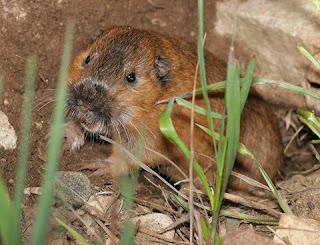Order Rodentia : Family
Geomyidae : Thomomys bottae (Eydoux and Gervais)
 Description
DescriptionA medium-sized rodent with external, furlined cheek pouches; the outer face of the upper incisors lacks conspicuous grooves; claws on front feet relatively small (less than 10 mm long); upperparts varying from pale gray to russet and blackish; underparts grayish-white, white, buffy, or mottled. External measurements average: (males), total length, 267 mm; tail, 81 mm; hind foot, 33 mm; (females), 219-69-28 mm. Weight (males), 160-250 g; (females), 120-200 g.
Distribution in Texas. Trans-Pecos Texas and eastward across the Edwards Plateau and immediately adjacent areas to Mason County.
Habits
Pocket gophers of this species are extremely adaptable as regards habitat. They occur in soils ranging from loose sands and silts to tight clays and in vegetative zones grading from dry deserts to montane meadows. Perhaps one reason why they can tolerate such environmental extremes is that they spend fully 90% of their lives in underground burrows, secure from the elements.
 Their burrow systems are often complicated structures consisting of two or more main galleries and several side chambers. A partly excavated burrow extended more than 30 m in length, had four main "forks," and averaged 6 cm beneath the surface, although the tunnel leading to the nest descended to a depth of more than 60 cm. Tunnel systems more than 150 m in length are not rare. These ramified travelways probably help the occupants to avoid predators that try to search them out; they are equally important in permitting the gopher to forage over a considerable area without exposing itself unduly to danger. Special side branches serve as storehouses for food, others as repositories for refuse and fecal pellets. In winter, when snow covers the ground, the gophers often extend their burrows into the snow and can then forage aboveground in safety.
Their burrow systems are often complicated structures consisting of two or more main galleries and several side chambers. A partly excavated burrow extended more than 30 m in length, had four main "forks," and averaged 6 cm beneath the surface, although the tunnel leading to the nest descended to a depth of more than 60 cm. Tunnel systems more than 150 m in length are not rare. These ramified travelways probably help the occupants to avoid predators that try to search them out; they are equally important in permitting the gopher to forage over a considerable area without exposing itself unduly to danger. Special side branches serve as storehouses for food, others as repositories for refuse and fecal pellets. In winter, when snow covers the ground, the gophers often extend their burrows into the snow and can then forage aboveground in safety.Although pocket gophers are active the year round, they store food to carry them over periods of scarcity, especially periods of drought when food is scarce and burrowing a difficult task. Usually, only one adult animal occupies each burrow system except for a short time in the breeding period. Associated with this solitary habit is a ferocious and seemingly fearless disposition. When two gophers encounter each other, they either fight or meticulously avoid each other. Desire for companionship seems to be completely lacking in their makeup.
They feed on a variety of foods, but fleshy roots and tubers are their main reliance. Unlike Geomys bursarius, Botta’s pocket gophers often come to the surface to feed and clip off vegetation around the burrow as far as they can reach in all directions without losing physical contact with the opening. If molested the animals back into the burrows with amazing speed. At other times, they approach desirable plants from below and pull the entire upperparts into the burrow where they can be cut up and stored or eaten at leisure. The roots of alfalfa are especially prized, but almost any native plant is potential food.
 The nest is a compact, hollow ball of dry, shredded vegetation placed in a special chamber off the main gallery, about 30-70 cm beneath the surface of the ground. Both sexes build nests as sleeping quarters.
The nest is a compact, hollow ball of dry, shredded vegetation placed in a special chamber off the main gallery, about 30-70 cm beneath the surface of the ground. Both sexes build nests as sleeping quarters.This species breeds continuously, with three marked periods of increased fertility — spring, summer, and early winter. The main breeding season is in spring, however; summer breeding is mainly by young females, possibly those born the preceding spring. The winter season is one of slight breeding activity and often merges with the one in early spring. Old females produce yearly an average of two litters of five young each; young females are less fecund. The young are blind, naked, unpigmented, and weigh about 4 g at birth. The ears are poorly developed, but the cheek pouches are fully formed although smaller proportionately than in adults. Growth appears to be relatively slow, but details of this phase of their life history are lacking.
 In cultivated areas, pocket gophers may be destructive and require control by trapping or poisoning, but on natural lands they are of decided benefit as soil builders. They are the chief natural cultivators of soils, and the maximum thrift of wild vegetation is dependent upon their continued activity.
In cultivated areas, pocket gophers may be destructive and require control by trapping or poisoning, but on natural lands they are of decided benefit as soil builders. They are the chief natural cultivators of soils, and the maximum thrift of wild vegetation is dependent upon their continued activity.
1 comment:
animal is unique,
Post a Comment